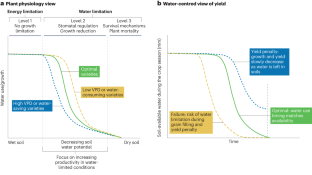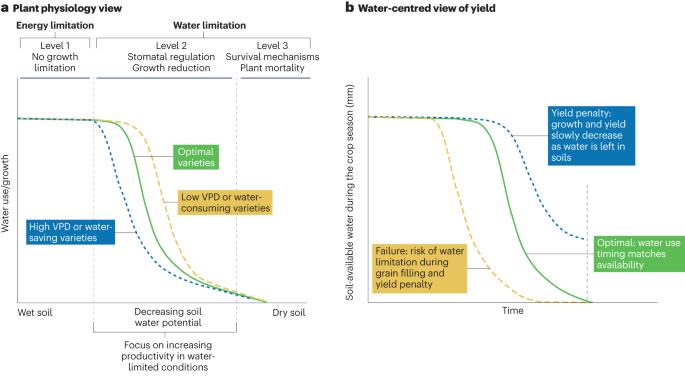Crop traits and production under drought
引用次数: 0
Abstract
Drought limits crop productivity and threatens global food security, with moderate drought stress — when crops grow at a reduced rate — commonly experienced. Increasing plant tolerance to moderate drought is a key target for adaptation and management, but efforts to understand and increase drought tolerance often focus on more extreme drought that causes complete crop failure and only consider crop genetics. In this Review, we discuss the influence of moderate drought on crop productivity and the role of physiological traits in drought tolerance and adaptation. Traits related to crop water use, water capture, water availability, transpiration efficiency and phenology impact drought adaptation, but their overall effect varies situationally. For example, early restrictions in transpiration, higher transpiration efficiency or altered tillering increase water availability during grain filling and can double yield in some drought scenarios. However, these same traits under less severe drought scenarios can also lead to yield penalties. To assess when and under what conditions traits will be beneficial, crop models are used to integrate the effects of genetics, the environment and management, estimating the expected yield responses under these combinations of scenarios and traits. More robust characterization of moderate drought tolerance and better integration between plant genetic information and modelling will enable the local selection of crop varieties suited to the expected drought scenarios. Moderate drought occurs widely, impacting crop yield. This Review discusses crop traits that can confer drought tolerance, the role of the environment and management, and how crop models predict their potential impact on yield.


干旱条件下的作物特征和产量
干旱限制了农作物的产量,威胁着全球粮食安全,中度干旱胁迫--农作物生长速度降低--是常见现象。提高植物对中度干旱的耐受性是适应和管理的关键目标,但了解和提高耐旱性的工作往往侧重于导致作物完全歉收的更极端干旱,而仅考虑作物遗传学。在本《综述》中,我们将讨论中度干旱对作物生产力的影响以及生理性状在抗旱性和适应性中的作用。与作物水分利用、水分捕获、水分供应、蒸腾效率和物候相关的性状会影响作物对干旱的适应,但它们的总体影响因情况而异。例如,早期限制蒸腾、提高蒸腾效率或改变分蘖期可增加谷物灌浆期的水分供应,在某些干旱情况下可使产量翻番。然而,在干旱不太严重的情况下,这些相同的性状也会导致减产。为了评估何时以及在何种条件下性状会产生效益,作物模型被用来整合遗传、环境和管理的影响,从而估算出在这些情况和性状组合下的预期产量反应。对适度耐旱性进行更有力的描述,以及更好地整合植物遗传信息和模型,将有助于在当地选择适合预期干旱情况的作物品种。
本文章由计算机程序翻译,如有差异,请以英文原文为准。
求助全文
约1分钟内获得全文
求助全文

 求助内容:
求助内容: 应助结果提醒方式:
应助结果提醒方式:


